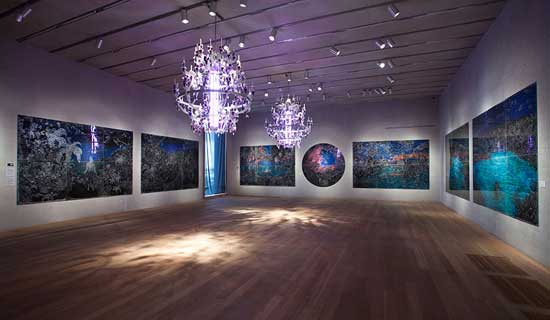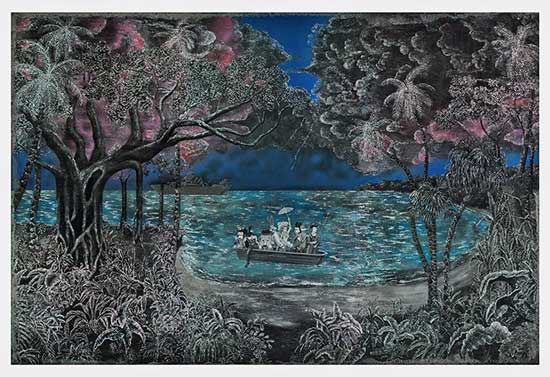The drop-dead gorgeous art sparkles in the dark. Moonlight and silver glitter supplant color and sunshine found in many Caribbean scenes.
Edouard Duval-Carrié concocts his sumptuous paintings and sculpture from centuries-old, caloric fantasies about Caribbean life, still promoting what we often think about the region today: an exotic destination rife with tourist-friendly islands selling the seductive elixir of sun-and-fun. But he also portrays a Caribbean like you've probably never seen.
So much glitter in his art flirts with kitsch.
His solo show at Pérez Art Museum Miami, "Imagined Landscapes," was planned months in advance to coincide with the much larger and more historically expansive "Caribbean: Crossroads of the World," at PAMM through August 17, 2014. Both exhibits dovetail thematically in unsettling ways.
.

"Edouard Duval-Carrié: Imagined Landscapes" installation view. Pérez Art Museum Miami. Courtesy the artist and Pan American Art Projects, Miami. Photo credit: Oriol Tarridas.
.
"Edouard's work resonates all across the Caribbean and in our collection," says PAMM Chief Curator Tobias Ostrander, who curated this solo show.
With nine paintings and two sculptures, "Imagined Landscapes" glows in a single gallery like a cache of rare jewels.
.

"Edouard Duval-Carrié: Imagined Landscapes" installation view. Pérez Art Museum Miami. Courtesy the artist and Pan American Art Projects, Miami. Photo credit: Oriol Tarridas.
.
Based in Miami, Duval-Carrié is a Haitian-born artist whose work has been exhibited internationally. He's a passionate scholar of Haitian and Caribbean history and cultural traditions. By turns brutal and beautiful, they inform his art. This show represents a new body of work created for PAMM.
For "Imagined Landscapes," Duval-Carrié studied artworks from the 19th Century and earlier depicting the New World's lush Caribbean, sometimes by artists who knew little if anything about the history of places they described.
Historically Flawed Fantasies
Theodor de Bry, a European 16th Century engraver and publisher, is a prime example of this tradition. De Bry never crossed the Atlantic but published many images of the New World, which were vastly influential in creating beguiling, if historically flawed, Caribbean fantasies. Their legacy is still evident.
Theatrically illuminating the gallery for "Imagined Landscapes," miniature Amerindian faces are modeled into the ornate violet and purple structure of Chandelier caraibes I (2013) and Chandelier caraibes II (2013). Those faces, Duval-Carrié explains, were inspired by de Bry's engravings of the Caribbean's indigenous population in books he remembers seeing when growing up in Haiti. "They were lily white and had these fantastic plumes over their heads," he says. "They were more fantasy than anything else."
.

"Chandelier caraïbes I" and "Chandelier caraïbes II" by Edouard Duval-Carrié, 2013. Resin and aluminum, Installation view Pérez Art Museum Miami. Courtesy the artist and Pan American Art Projects, Miami. Photo credit: Oriol Tarridas
.
After Heade--Moonlit Landscape (2013) is Duval-Carrié's exquisite response to a painting by American artist Martin Johnson Heade, View from Fern-Tree Walk, Jamaica (1887), created after sketches Heade made in Jamaica over a decade earlier. Heade, particularly admired for his detailed renderings of orchids amid jungles, took several trips seeking subject matter in the Caribbean and Central and South America during the years 1863 to 1870.
.

"After Heade: Moonlit Landscape" by Edouard Duval-Carrié, 2013. Mixed media on aluminum, 96 x 144 inches. Courtesy the artist and Pan American Art Projects, Miami. Photo credit: Ralph Torres.
.
Human figures are often absent from Heade's botanical paradise. There's no suggestion that Jamaica was once home to lucrative slave-holding sugarcane plantations, fueling an international economy that valued sugar as we now do oil.
With his own eye for detail, Duval-Carrié echoes the composition of Heade's lush landscape, yet he inserts a faceless male figure front and center, hard-to-miss and mysterious. This figure is surely a metaphor, suggesting that Caribbean imagery has long been, in fact, much more imaginary than many realize.
In After Bierstadt--The Landing of Columbus (2013), Duval-Carrié riffs with caustic humor on a painting by Albert Bierstadt. The German-born Bierstadt was celebrated for his 19th Century iconic paintings of the American West, exalting the region's vistas while also encouraging Western expansion.
.

"After Bierstad - The Landing of Columbus" by Edouard Duval-Carrié, 2013. Mixed media on aluminum, 96 x 144 inches. Courtesy the artist and Pan American Art Projects, Miami. Photo credit: Ralph Torres.
.
Duval-Carrié refers to Bierstadt's The Landing of Columbus (1893), showing Christopher Columbus and crew making landfall on an island now part the Bahamas. In Bierstadt's imaginative retelling, these so-called New World Discoverers are elegantly dressed and praising God. Of course, as both "Imaginary Landscapes" and "Caribbean: Crossroads of the World" incisively illustrate, this world is indeed very old with a complex history predating Columbus.
Mickey Mouse and Marie Antoinette
In Duval-Carrié's retelling, a small boat making landfall carries an anachronistic crew: Christopher Columbus garbed like a 15th Century European courtier, Mickey and Minnie Mouse, Mr. Potato-Head, and Batman, not to mention that ill-fated femme fatale, Marie Antoinette. This island paradise represents Haiti, invaded not only by murderous fallout from the French Revolution but by Disney merchandising. Lurking near the horizon is a massive military boat, alluding to "gunboat diplomacy" that the U.S. has often employed in Haiti and elsewhere in the Caribbean.
Regarding the baroque, be-glittered, and close-to-kitsch sparkle of "Imaginary Landscapes," Duval-Carrié says, "I just wanted to sugarcoat the whole thing! Had I been able to do it with sugar, I would have made it with sugar." His provocative art carries thematic parallels with a stunning installation in Brooklyn by Kara Walker, which employs tons of sugar to tell disturbing, highly un-sugarcoated stories.
Look for more of Duval-Carrié's arresting take on the Caribbean. In November 2014, the opera Makandal premieres at New York's Harlem Stage. Partly inspired by Francois Makandal, an 18th Century Haitian revolutionary who led a failed slave revolt, the opera incorporates art by Duval-Carrié.
_____________________
BASIC FACTS: "Edouard Duval-Carrié: Imagined Landscapes" continues through August 31, 2014. The exhibition is located at Pérez Art Museum Miami, 1103 Biscayne Blvd., Miami, FL 33132. www.pamm.org
______________________
Copyright 2014 Hamptons Art Hub LLC. All rights reserved.
